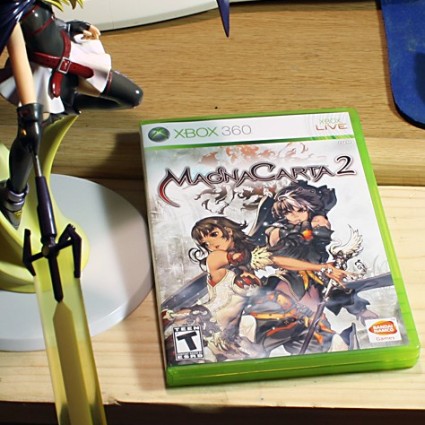
Firmly entrenched in its role as the anchor of the Japanese console sales charts, the Xbox 360 is an unlikely platform for JRPG development, but for some reason it’s gotten its share of them. Here’s one of the most recent examples; Magna Carta 2 is the sequel to a poorly-received PlayStation 2 game, which itself is a derivative of an older PC game. It came out early this month in the United States, and being curious as to what it’s about, I went and picked it up.
To be pedantic, Magna Carta II is not actually a JRPG, having been developed by the Korean company Softmax. However, after playing it for a few hours it evokes not Final Fantasy or Star Ocean; rather, it feels most like World of Warcraft. Combat takes place on the area map, and you simply move your character into a monster’s aggro radius and press the combat mode button to initiate hostilities. To discourage button mashing, your character’s attacks and spells fill up a stamina gauge; when the gauge is filled, your character cannot attack until a cooldown period elapses. To activate special attacks, you need to connect with a series of regular attacks or cast spells to build up something called a kan gauge. For melee fighters, this gauge functions similarly to a Warcraft warrior’s rage bar (although it does not deplete over time), and for casters, it means you have to remain stationary to cast your stronger spells.
The game is filled with side quests, and at least early on, they do not often deviate from the “Fetch 5 widgets†or “Kill 8 armadillos†motif seen so witheringly often in MMOs. There’s also a gathering minigame where you can pick up flowers and other assorted foliage, as well as a bombing minigame which is very similar to how grenades are thrown in Warcraft.
The main character is named Juto, and if you have any experience playing JRPGs (or watching anime), you’ve almost certainly seen his archetype before. Brash, self-righteous, and afflicted with a curious disability that disengages his brain when he opens his mouth, he is the very epitome of the generic teenaged JRPG hero. He also suffers from amnesia, so his past is conveniently clouded, and he just as conveniently show hints of great power locked within himself. His running mate is Zephie, a princess and military leader who cares deeply for everyone under her command and wishes to make a better world for everybody. You’ve seen this sort of female character type before, too. I am told there are six playable characters in total, but I’ve only gotten five so far.
Despite its unoriginality, Magna Carta 2 is still a pretty fun game. The combat is fairly fast-paced and the statistical character development – which, like Warcraft, lets you customize your characters using talent trees – is interesting. The story is banal but even so, the rebel group trying to fight off usurpers to restore justice and order is a classic plot type. The character designs are very nice, having been done by well-known Korean artist Hyung Tae Kim, and I’ll fully admit that his artwork factored heavily into this purchase. The voice acting is pretty good, although I would’ve liked to have had the Japanese voices with subtitles.
I placed a preorder for this game at my local Gamestop store since I didn’t think they would get many copies and also because they were giving away a free artbook for doing so. When I went to pick up the game, I inquired about the preorder freebie, and the clerks stared back at me, slack-jawed, as if I were speaking Mongolian. I guess the artbooks didn’t ship with the games to this store. I went home and sent an e-mail to Gamestop’s feedback site, and I actually got a response, so hopefully I get my artbook mailed to me. The artbook itself isn’t a big deal to me but I am very much annoyed when Gamestop advertises some preorder freebie and then they say, “Oh, we don’t have them here, sorry,†when you go to get it.










